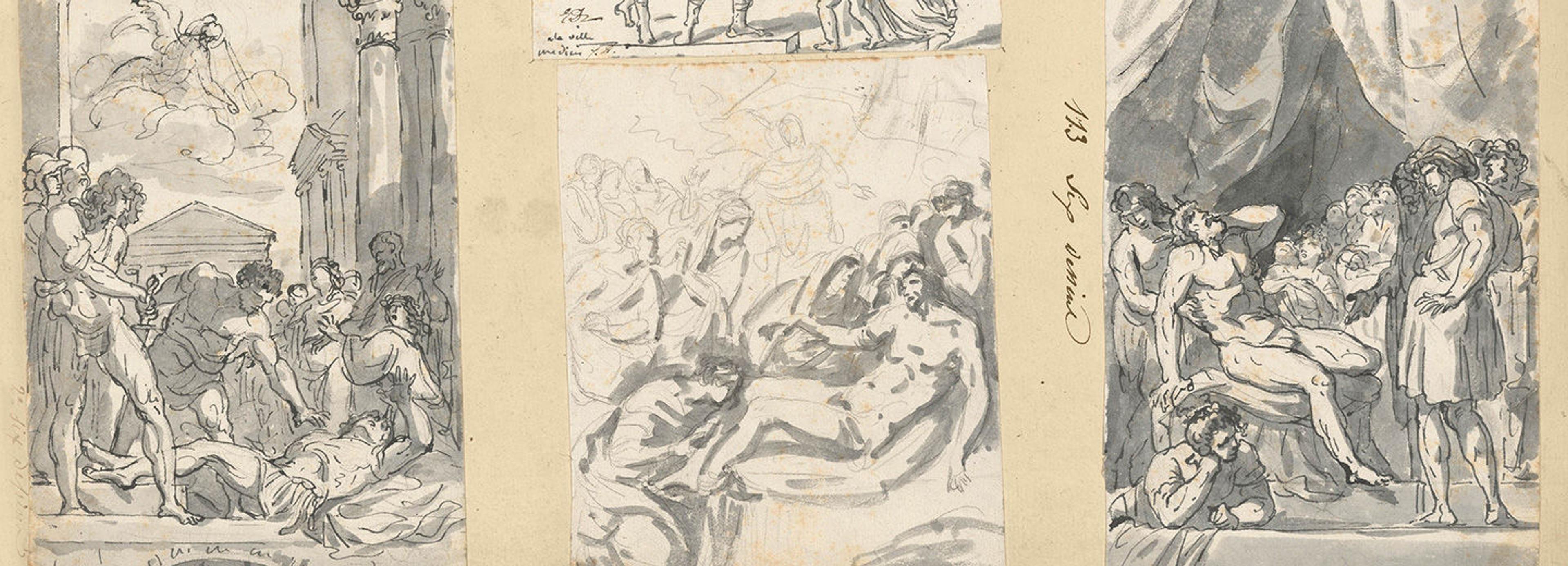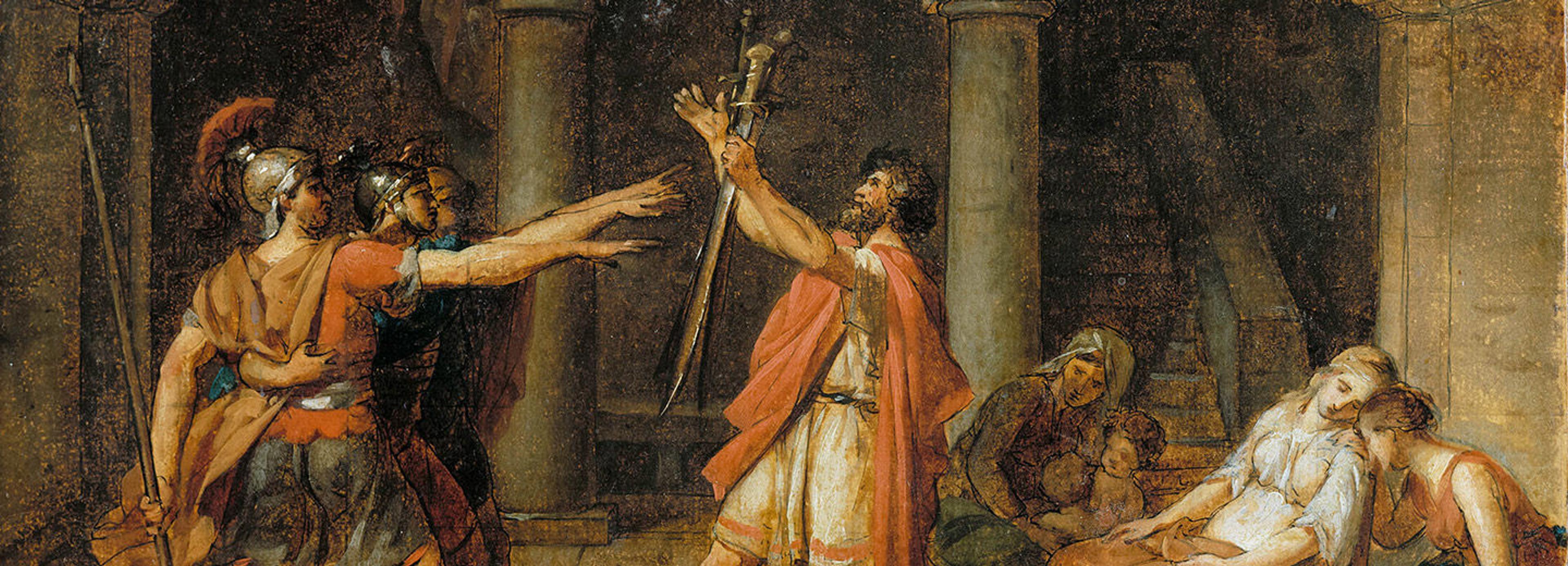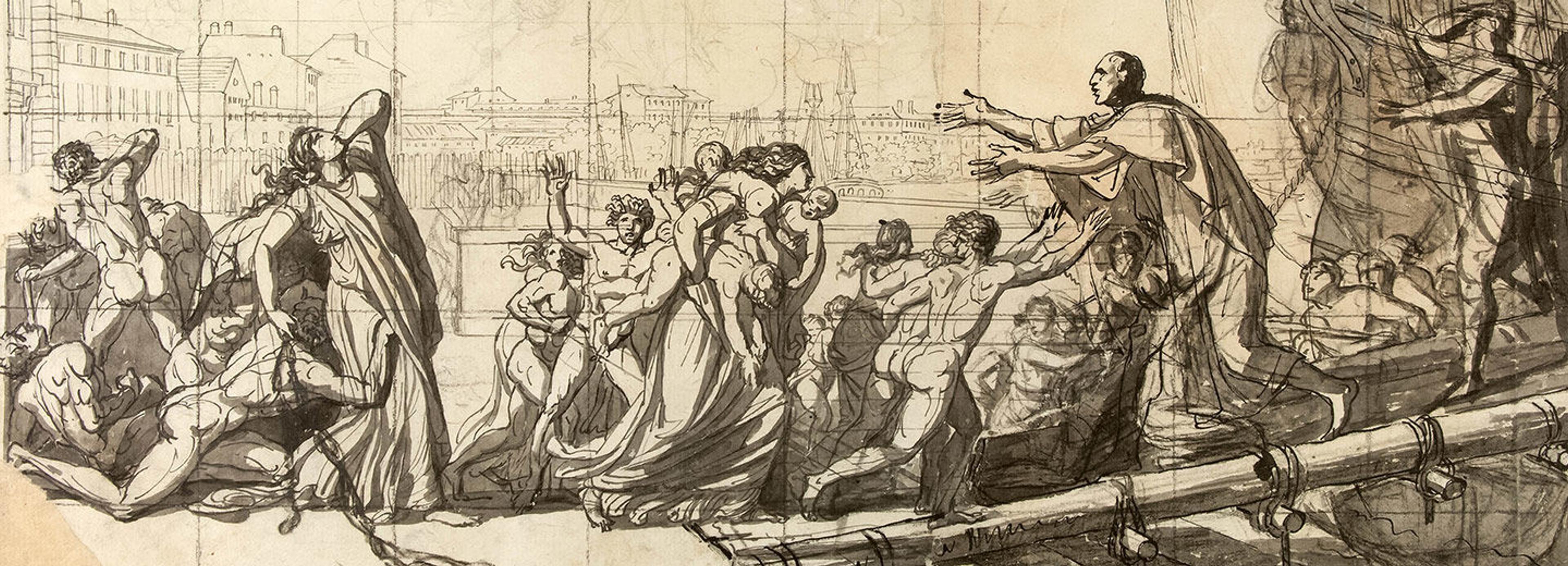Building a Foundation, 1764-80

At age 9, following the death of his father, Jacques Louis David was left in Paris to be raised by two maternal uncles. By the mid-1760s, he had entered the studio of the painter Joseph Marie Vien. His early years were marked by setbacks and losses, including three failed attempts to win the Prix de Rome, the scholarship that allowed young French artists to study in Italy.
After finally winning on his fourth try, he arrived in Rome in 1775 and set about recording the city’s artistic riches in his sketchbooks. In retrospect, this assembling of a vast store of motifs for future use appears intentional, the industry of an aspiring painter aiming to reinvent French art.
That his style transformed dramatically during his time in Italy is clear from works securely dated to the end of his stay. Several drawings dated 1779 show him exploring ideas for paintings. Their compositions take their inspiration from antiquity—in their subjects, their sculptural figures, and their simple, planar compositions.
Selected Artworks
Press the down key to skip to the last item.
A Rising Star, 1780-89

Back in Paris by 1780, David quickly gained membership in the Académie Royale, an official arm of the monarchy’s arts administration that exerted control over teaching, exhibitions, and commissions. The works he submitted for display at the biennial Salons heralded a powerful new Neoclassical style, characterized by planar compositions and sculptural figures. Works like The Oath of the Horatii and The Death of Socrates became instant classics, buttressing his growing reputation as leader of the French school.
He married Marguerite Charlotte Pécoul in 1782, a union that produced four children. Following the success of his paintings at the public exhibitions mounted by the Académie Royale, students flocked to study with him. Among them can be counted many of the great painters of the next generation. By the end of the decade, David’s standing was firmly established, but the events of the Revolution, beginning in 1789, would lead to major upheavals—and opportunities—for artists in France.
Selected Artworks
Press the down key to skip to the last item.
Artist of the Revolution, 1789-99

The 1789 Revolution transformed France. For David, who had strained against the strictures of the arts administration under the monarchy, the change was a welcome one. He led the charge to reform to the Académie Royale, an institution he saw as elitist and undemocratic. The Jacobin Club, a group that argued for “extreme egalitarianism,” counted him among its members.
Established systems of art patronage were dismantled. The very notion of what constituted suitable subject matter underwent a sea change. Instead of depicting the legends of ancient history, David celebrated the triumphs of the Revolution and memorialized its martyrs. To serve the young Republic, established in 1792, he even lent his talents to such everyday tasks as designing uniforms for officials.
In 1794, following one of the bloodiest phases of the French Revolution, known as The Terror, came a period of reaction against the most radical elements of the new Republican government. David was arrested, along with other allies of the fallen revolutionary Maximilien Robespierre. While behind bars and after his release the following year, the artist campaigned—in writing and more subtly through his art—to clear his name in the eyes of the public.
Selected Artworks
Press the down key to skip to the last item.
The Napoleonic Era, 1799-1816

After his release from prison in 1795, David would spend years laboring on a major canvas, The Intervention of the Sabine Women (Musée du Louvre, Paris). A legend from the founding of ancient Rome, the subject was clearly intended to be read as a call for reconciliation to a nation still riven by the events of the Revolution and its aftermath.
By the dawn of the nineteenth century, the Corsican-born general, Napoléon Bonaparte was rapidly gaining power. David appears to have come to the conclusion that his path to further glory would depend on obtaining patronage for the type of large-scale paintings that had made his reputation in the 1780s. To this end, he decided to hitch his fortunes to those of Napoleon, memorializing the glittering spectacles orchestrated to mark the general’s ascent to emperor.
Between official commissions, he would revert to his perennial source of inspiration: tales of classical antiquity. He chose and developed his subjects with care, employing them, as was his long habit, as a veiled means of commentary on contemporary society.
Selected Artworks
Press the down key to skip to the last item.
Artist in Exile, 1816-25

By 1816, a string of military defeats led to Napoleon’s downfall and the restoration of the Bourbon monarchy David had openly opposed. Banished by the new government, David lived out his final decade in exile in Brussels. He would send a few canvases back to Paris, but for the most part his late drawings show a pivot to the personal. He made portraits of his family members, but also more enigmatic drawings featuring cropped figures that recall the period of David’s greatest fame but read as fragments, floating across the sheet like untethered memories.
Selected Artworks
Press the down key to skip to the last item.
